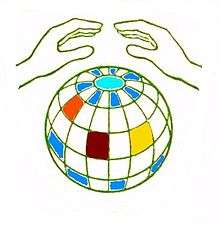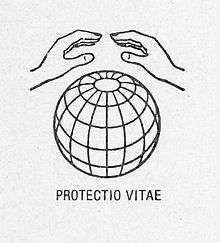World Union for Protection of Life

The World Union for Protection of Life (German: Weltbund zum Schutz des Lebens, French: Union Mondiale pour la Protection de la Vie, Russian: Всемирный союз для защиты жизни) is an international non-profit organization and non-governmental organization which was founded 1958 in Salzburg (Austria) by the writer Günther Schwab. The concept Protection of Life is considered to be different from the protection of the environment as it has been used by the United Nations Environmental Program (UNEP), though that organization was founded as a result of the United Nations Conference on the Human Environment in 1972.
Günther Schwab is known as the author of the screenplay for the movie Der Förster vom Silberwald (Heimatfilm, literally homeland film), released 25 November 1954 in Vienna (as Echo der Berge) and 8 February 1955 in Munich. In his novel Der Tanz mit dem Teufel (Dance with the Devil) Günther Schwab gives his expressions to sentiments for nature protection and describes the destruction of nature as a plan of a devil who seems really existent. The book was translated in many languages, the first English translation was published 1963. In the year 1958 Schwab started to set up an organization with the name World Union for Saving of Life which was registered as World Union for Protection of Life two years later and soon activated branches in more than 30 countries all over the world.
Germany
International congresses with scientist and church organizations mainly took place in German speaking countries. Around the year 1968 the organization had several thousand members in the Federal Republic of Germany. Famous members were the physicist Karl Bechert[1] and the chemist Hans-Adalbert Schweigart.
The organization played an active role during the foundation of the German Green Party, especially in Lower Saxony.[2]
Austria
The organization was officially registered as World Union for Saving of Life on 24 September 1958 in Salzburg and is therefore one of the oldest anti-nuclear organization. One of the famous members was the biologist Annie Francé-Harrar. The Austrian anti-nuclear power activist Robert Jungk engaged himself for the WUPL.[3] According to the Federal Ministry of the Interior (Austria) the national section was dissolved at December 31, 2012.
International activities

According to its own publications the WUPL had sections in Australia, Egypt, Ethiopia, Belgium, Brazil, Bulgaria, Canada, Czechoslovakia, Finland, France, Germany, Great Britain, Hungary, India, Ireland, Israel, Italy, Japan, Luxembourg, Mexico, Netherlands, Norway, Poland, Romania, Sweden, Switzerland, Spain, South-Korea, South-Africa, Yugoslavia and USA.
A scientific advisory board of 400 scientists out of 53 countries supported the work of the organization. Among them were 40 Nobel laureates. President of the board was Linus Pauling. Günther Schwab himself held about 1500 public readings.
In Australia the WUPL tried to ward off the dangers connected with the building of the Atomic Reactor at Jervis Bay, only about 130 miles from Sydney.[4]
The World Union for Protection of Life gave the Hans-Adalbert-Schweigart-Medal to:
- 1979: André Gernez and Konrad Lorenz
- 1983: Rosalie Bertell[5]
- 1986: Franz Weber
- ????: Ralph Graeub[6]
- ????: Peter Weish
The seat of the international organization changed over the course of time, for example from Hannover to Bad Reichenhall.[7] After the death of Günther Schwab in 2006 there was a restructuring.
In 2008 – 50 years after foundation – the organization pledged for the Global Population Speak Out (GPSO).[8] Since 2009 the international stage was activated by scientists in 13 countries. For many organizations with similar goals has been set up since the 1970er, today the WUPL is only open for elected representatives of organizations with equal goals and members with a scientific qualification. In October 2009 the German text of the foundation document was published in the internet.[9] International Members took part in the United Nations Climate Change Conference 2009.
References
- ↑ http://www.fes.de/archiv/1abt/beche-k.htm
- ↑ "Die Beteiligungsformen der Grünen Parteien ..." Dissertation for doctorate, written by Kuei-Hsiang Liao, 2000
- ↑ LSI – Lebensschutzinformationen Heft 6/1983
- ↑ Letter from President of the South East Asia and Oceanic Region, Harry F. Kurth, Sydney, 8 April 1972
- ↑ http://www.hc-sc.gc.ca/hl-vs/pubs/women-femmes/can-usa/can-author-auteur_2-eng.php
- ↑ http://www.udeo.ch/html/graeub.html
- ↑ Yearbook of International Organizations. Brussels http://www.uia.org
- ↑ List of GPSO Pledges published in February 2009
- ↑ https://www.xing.com/net/wupl
Bibliography
- Radkau, Joachim. Nature and Power. A Global History of the Environment. Cambridge University Press 2008.
- Schwab, Günther. Dance with the devil. A dramatic encounter. Geoffrey Bles, London 1963.
External links
- UNEP, Official Website www.unep.org
- WUPL, Official Website wsl-int.de